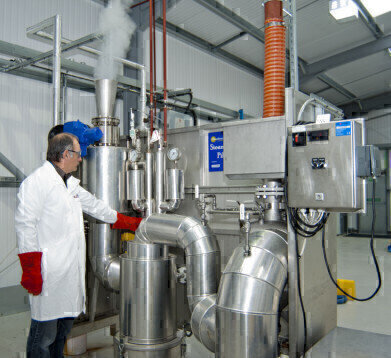-
 Pilot Steam Explosion Unit in the Biorefinery Centre at Norwich Research Park
Pilot Steam Explosion Unit in the Biorefinery Centre at Norwich Research Park
News & Views
Oilseed Straw Assessed as Possible BioFuel
Jul 20 2014
Researchers at the Institute of Food Research investigating the convertion of surplus annual straw stock from oilseed rape into biofuel, have been discovering insights into how the process could be made more efficient, as well as how the straw itself could be improved.
For straw stock to be turned into a biofuel, a pre-treatment stage is necessary to enable enzymes to convert complex carbohydrates (saccarification) into a glucose form suitable for fermentation into ethanol.
Professor Keith Waldron and his team have been using facilities at the Biorefinery Centre on Norwich Research Park to look at the pre-treatment steps, particularly the use of steam explosion to drive a number of chemical reactions in the biomass. A rapid pressure-release following this ‘pressure cooking’ causes the material to be ripped open further improving accessibility to the stored sugars.
They varied the temperature and duration of steam explosion and then used a variety of physical and biochemical techniques to characterise what effects varying the pre-treatments had on the different types of sugars before and after the saccharification.
In a further study funded by the BBSRC / EPSRC Integrated Biorefining Research and Technology Club, the scientists discovered the key factors that determine the efficiency of the saccharification process itself.
One particular compound, uronic acid, was found to limit the rate at which enzymes worked, while final sugar yield was closely related to the removal of xylan, a common component of plant cell walls. The abundance of lignin, a ‘woody’ cell wall component, was positively related to the amount of available sugars.
Using these findings the IFR is now working with colleagues at the University of York and the John Innes Centre to see whether there are ways of breeding more “biofuel-ready” varieties of oilseed rape, with the same yields of oilseed but with more amenable straw.
In addition, a full understanding of the polysaccharides and other compounds made available during pretreatment may mean other valuable co-products, like platform chemicals, may be viably produced from the surplus straw.
References:Steam explosion of oilseed rape straw: Establishing key determinants of saccharification efficiency, Bioresource Technology 162, 175-183 doi: 10.1016/j.biortech.2014.03.115 Changes in the composition of the main polysaccharide groups of oil seed rape straw following steam explosion and saccharification, Biomass and Bioenergy 61 121-130 doi: 10.1016/j.biombioe.2013.12.003
Digital Edition
Lab Asia 31.2 April 2024
April 2024
In This Edition Chromatography Articles - Approaches to troubleshooting an SPE method for the analysis of oligonucleotides (pt i) - High-precision liquid flow processes demand full fluidic c...
View all digital editions
Events
Apr 22 2024 Marrakech, Morroco
Making Pharmaceuticals Exhibition & Conference
Apr 23 2024 Coventry, UK
Apr 23 2024 Kintex, South Korea
Apr 23 2024 Seoul, South Korea
Apr 24 2024 Jakarta, Indonesia







.jpg)









